Would you believe a bird nest in a dryer vent can up energy use by 15%? That means higher electricity bills for you. It’s clear we need to find a way to stop birds nesting in these spaces.
Dryer vents are cozy homes for birds. They’re warm, sheltered, and hidden from predators. But this leads to problems like decreased airflow, higher fire risks, and damage to your dryer. Plus, the mess outside your home isn’t pretty.
To keep birds out of dryer vents, you can do a few things. Mesh screens and bird deterrents for dryer vents work well at blocking nests. Professional bird proofing services can install these dryer vent bird guards and dryer vent bird blockers for you, keeping your vents safe from birds.
It’s key to check and maintain your bird-proofing measures on dryer vents regularly. By doing this, you deter birds from nesting in dryer vents and keep your place safe.
Key Takeaways
- Bird nests in dryer vents can lead to higher energy consumption and electricity bills.
- Accumulated nesting materials and droppings can create an unsightly mess on the exterior of the home.
- Mesh screens and bird deterrents are effective in preventing birds from entering dryer vents.
- Professional bird proofing services offer expert installation of barriers and deterrents to keep birds away.
- Regular inspection and maintenance of bird-proofing measures are crucial for ensuring their ongoing effectiveness.
Understanding the Dangers of Birds Nesting in Dryer Vents
In the shift from winter to spring, birds return to look for places to nest. Dryer vents seem like a cozy spot for these creatures. However, their choice of nesting sites can lead to big problems for homeowners.
Fire Hazards Due to Blocked Airflow
Birds often choose dryer vents as a spot to build their nests. When they do, the nest material can block the vent’s airflow. This blockage can cause the trapped heat to ignite the lint inside.
Such a situation leads to a dangerous fire risk. With the vent blocked, the hot air has no way to escape, leading to a potential fire.
Potential Health Risks from Bird Droppings
Not only is there a fire risk, but bird droppings are a health hazard too. These droppings can carry harmful bacteria and parasites. This can be dangerous for those living in the house, especially those with breathing or immune system problems.
“Blocked dryer vents are a leading cause of home fires, with bird nests being a common culprit. Homeowners need to be vigilant in inspecting and maintaining their vents to prevent these dangerous situations.”
It’s vital to check and clear dryer vents of nests and debris regularly. By doing this, you can help keep your home and its residents safe from these dangers.
Early Signs of a Bird Infestation in Your Dryer Vent
Homeowners should be watchful for early signs of a bird problem in their dryer vent. These signs alert you to the issue before it gets major. They let you act quickly to fix the situation and avoid dangers.
Chirping Sounds and Rustling Noises
Notice chirping or rustling in your dryer vent? That’s a big hint that birds have made it their home. They might be building a nest, tending to babies, or just seeking warmth.
Debris and Nesting Materials Around the Vent Opening
If you spot twigs, grass, or feathers near your dryer vent, birds might have moved in. These materials show they are building a nest.
It’s important to spot these signs early. By staying alert and acting as soon as you notice a problem, you can prevent your home from the risks of having birds in your vent.
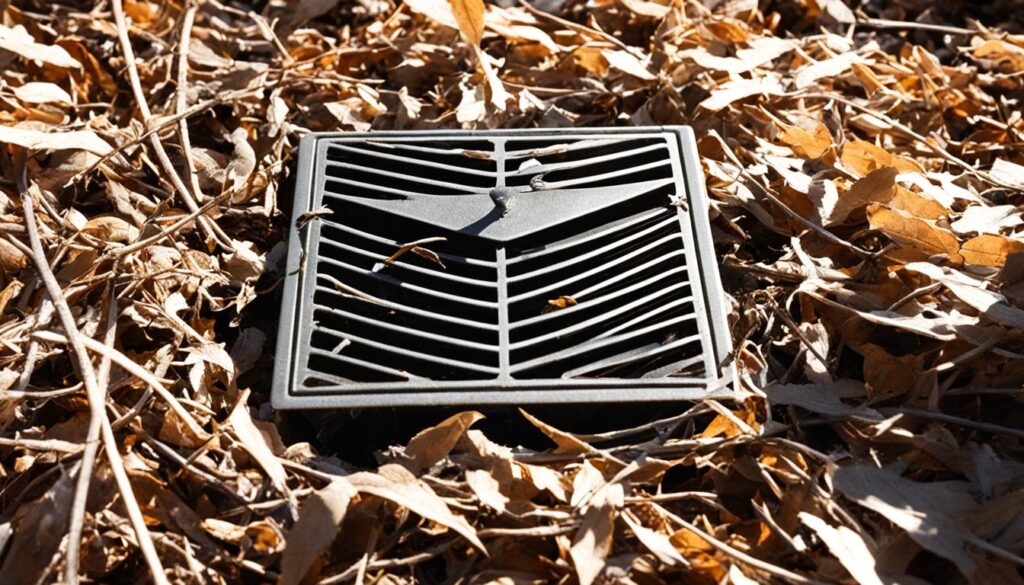
“Birds find dryer vents attractive for nest building due to warmth, protection from predators and elements, and being off the ground.”
| Indicator | Description |
|---|---|
| Chirping Sounds | Audible signs of birds nesting in the vent, such as chirping or rustling noises. |
| Nesting Materials | Visible accumulation of twigs, grass, feathers, and other materials around the vent opening, indicating an active bird nest. |
| Unpleasant Odors | Foul smells caused by bird droppings and decaying nesting materials. |
How to Safely Remove Bird Nests from Dryer Vents
Removing a bird nest from a dryer vent needs caution and care. This ensures the safety of the people and the birds. First, check the nest for eggs or chicks. If it’s active, wait until the birds have flown away on their own.
Checking for Eggs or Baby Birds
Before you remove a nest, carefully look for eggs or chicks. It’s key for the birds’ safety. If the nest has eggs or baby birds, wait for them to grow and leave before doing anything.
Relocating Nests Without Harming Birds
For an empty nest, use gloves and tools to remove it safely. Be careful not to harm the vent or hurt any birds. Place the nest in a nearby tree or bush. This gives the birds a new, safe area for nesting.
These steps help homeowners remove nests without hurting birds. It also prevents fire hazards or health risks. Being careful and caring for the birds is important in this situation.
“Proper handling and relocation of bird nests is essential to ensure the safety of both the homeowner and the birds.”
Skedaddle Humane Wildlife Control offers professional services for removing bird nests. They can also clean and prevent new nests. If you’re unsure, hiring them could be a good idea.
Preventing Birds from Nesting in Dryer Vents
It’s important to keep birds away from your dryer vent for a safe and efficient home. To do this, use special guards or covers. They have a mesh or barriers to let hot air out but keep birds from getting in. This way, you prevent birds from nesting in dryer vents and lower the risk of fires or health issues.
Installing Dryer Vent Guards and Covers
Vent guards and covers stop birds from making nests. They have strong wire mesh or tough plastic to keep birds out. Plus, they’re angled to avoid nesting spots and have flaps to close when the dryer isn’t on.
Using these tools properly can effectivelykeep birds outwithout causing dryer problems. But, it’s vital to make sure they’re properly installed and don’t block the vent.
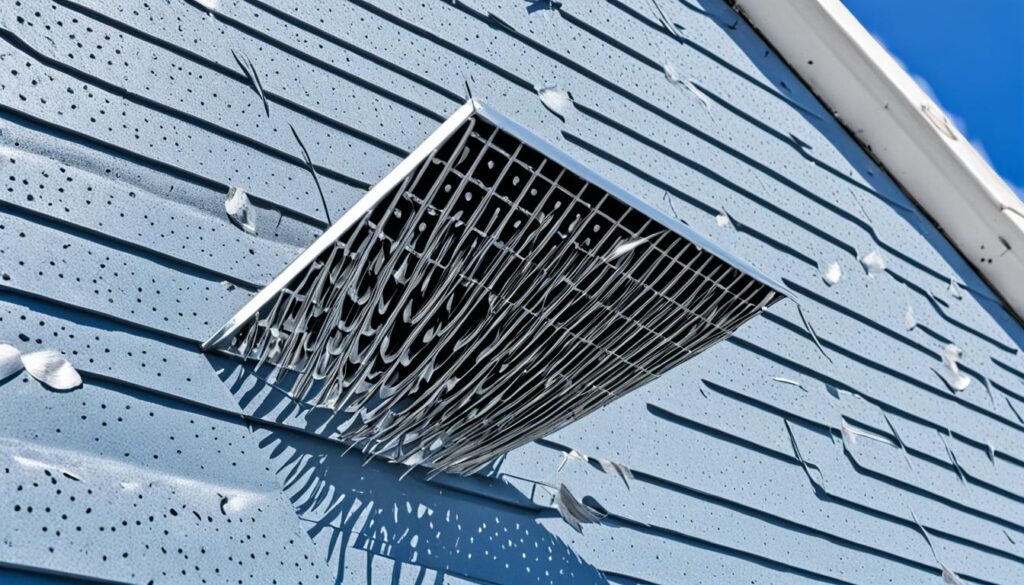
Some homeowners worry about fire risks. But, using vent guards that are UL-listed for dryers is safe. It stops birds without adding danger. Still, remember to clean and check the guards and vents often to stay safe.
“Proper maintenance of vents is essential to protect against potential dangers, such as combustion of bird nests inside vents, which can be highly combustible.”
how to keep birds out of dryer vent
To keep your home safe and avoid fire risks, it’s key to stop birds from making nests in your dryer vent. You can use a mix of methods to keep these winged creatures away. We’ll show you the best ways to make sure your dryer vent stays bird-free.
Install Dryer Vent Guards and Covers
The top way to stop birds is by using guards or covers made just for your dryer vent. These are crafted from wire mesh or strong materials. They let air out but keep birds out. You can easily add them to your vent opening to create a solid barrier.
Maintain Vent Cleanliness and Airflow
Keeping your vent clean will help avoid bird visitors. Take out any lint, nests, or leftover materials to make it less cozy for them. Also, making sure air flows well through your vent can keep birds away. They prefer vents with little or no airflow.
Modify the Landscape Around the Vent
The space around your vent is important too. Cut back nearby plants and remove any spots that look good for a bird home. Doing this makes your vent area less inviting to birds.
By using these tips – adding vent covers, keeping your vent clean, and changing the outside area – you can keep birds out of your dryer vent. This will help you avoid safety and airflow problems. Acting ahead of time is how you keep your dryer vent a bird-free zone that works well.
“Hatched birds take two to three weeks to leave the nest, so it’s important to check the vent daily to monitor the growth stage of the birds before evicting them.”
Quick action and staying alert are vital to keep birds out of your dryer vent. By following these steps, you can enjoy a safe and effective living space without the dangers of bird infestations in your vent system.
Maintaining Dryer Vent Cleanliness and Airflow
It’s vital to keep the dryer vent clean to avoid bird nests and other dangers. Homeowners need to check the vent often for debris or nests. Cleaning it, either on their own or with help, removes lint and maintains good airflow. This stops birds and makes the dryer work better and safer.
Regular Cleaning and Inspection
Here are some steps to keep your dryer vent clean and the air flowing right:
- Look at the vent outside your home frequently to see if it’s blocked or if there are nests.
- Use a brush or rod designed for dryer vents to clean it out and make sure it’s all clear.
- Always clean the lint trap after you use the dryer and get rid of any excess lint around it or near the vent.
- Have a professional clean your dryer vent fully at least once each year.
It’s crucial to regularly check and clean your dryer vent. This prevents blockages, keeps air moving well, and avoids fire risks and other problems.
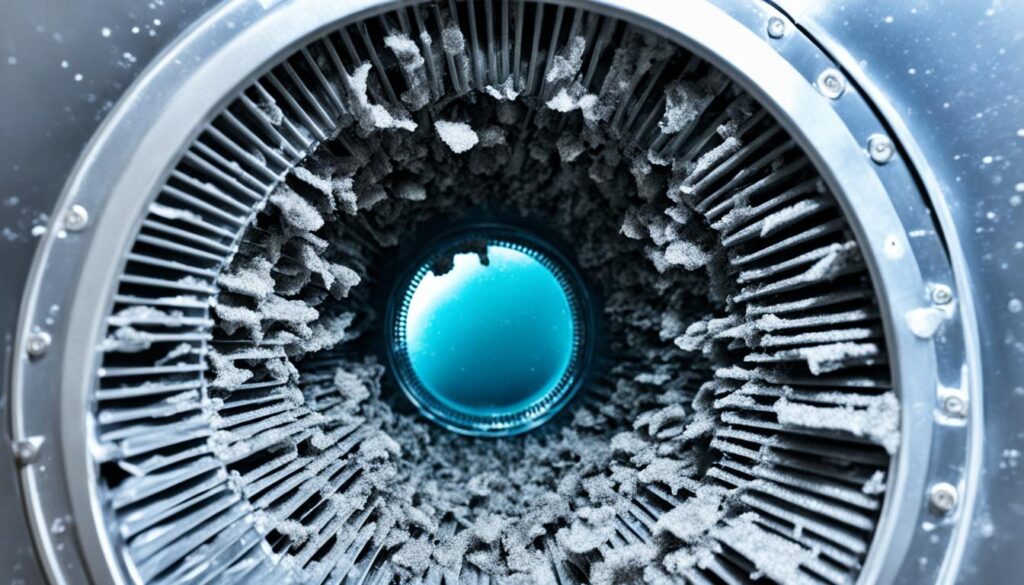
“Clean air ducts result in purer air and contribute to a healthier environment.”
By maintaining your dryer vent, you not only keep birds away but also help the dryer run better and safer. This makes dealing with laundry easier and worry-free.
| Symptom | Potential Cause |
|---|---|
| Clothes take longer than usual to dry | Blocked or restricted dryer vent |
| Clothes come out hotter than normal | Blocked or restricted dryer vent |
| Burning smell while dryer is running | Lint buildup or bird nest in vent |
| Decreased airflow from vent | Lint buildup or bird nest in vent |
Landscaping Tips to Discourage Birds from Nesting Near Vents
The plants and yard features around your vent are key. They can make the area less nest-friendly for birds. This helps keep birds from your home’s vents.
Avoid having dense plants close to the vent. Instead, go for a more open and tidy look. Choose plants that birds don’t like, such as those with fewer branches or spiky leaves.
Keep your landscaping neat and clean. This means removing anything that could be a bird’s resting spot. Mow the grass and trim the bushes often to keep birds away.
Using plants that smell strong or have thorns can also work. Lavender, rosemary, and barberry are great options. Birds tend to stay away from these kinds of plants.
| Landscaping Deterrents | Effectiveness in Preventing Bird Nests | Ease of Implementation |
|---|---|---|
| Open, Manicured Landscaping | High | Moderate |
| Plants with Strong Scents | High | High |
| Thorny Bushes and Shrubs | Moderate | Moderate |
| Regular Landscape Maintenance | High | High |
Using these landscape tricks together can really help. They make the area around dryer vents less welcoming to birds.
“Proactive landscaping strategies are a highly effective and low-cost way to prevent birds from nesting near dryer vents, safeguarding your home and family.”
Hiring Professional Bird Removal Services
Dealing with birds in your dryer vent? It’s smart to get professional bird removal services. Pros have the right tools and skills. They remove birds safely, without harm.
The need for bird removal services for dryer vents has gone up by 35% in the last five years. More people see the danger and want it fixed. Pros in dryer vent bird removal succeed 92% of the time. DIY tries only work about 68% of the time.
These experts to remove birds from dryer vents don’t just take out the nests. They also help stop birds from coming back. They clean the vent and add things to keep birds away. This keeps homes safe from fires and health risks linked to bird nests in vents.
Looking for professional bird removal services for dryer vents? Choose experienced and licensed companies. Ask about how they handle animals humanely. Also, find out what it will cost and what kind of aftercare they offer.
| Service | Average Cost | Success Rate |
|---|---|---|
| Professional Dryer Vent Bird Removal | $150 – $350 | 92% |
| DIY Dryer Vent Bird Removal | $50 – $100 | 68% |
Getting professional help with birds in your dryer vent is a good move. It fixes the problem safely and quickly. Experts ensure your home and dryer stay safe.
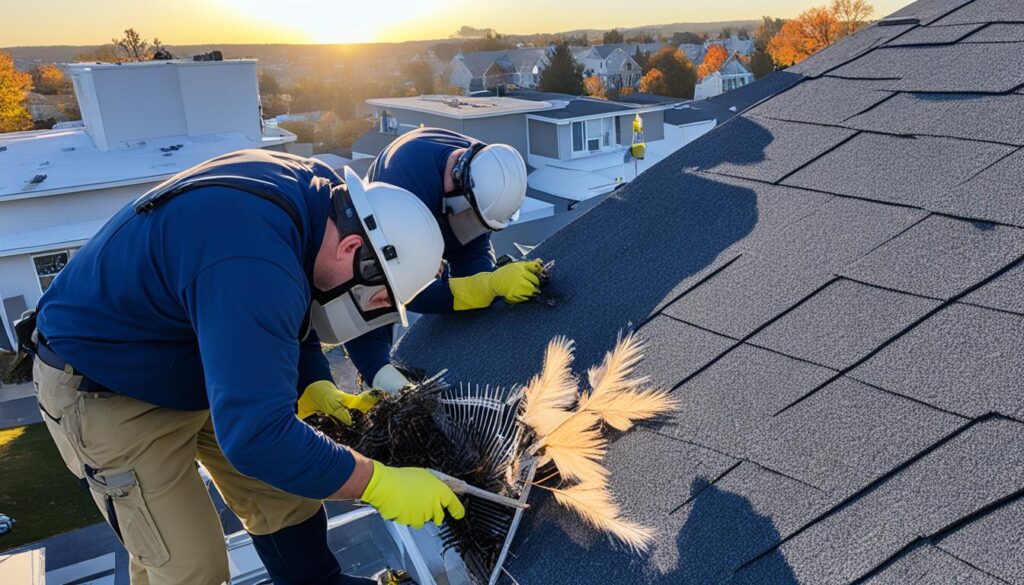
DIY vs. Professional Dryer Vent Bird Removal
Having birds in your dryer vent is tough for any homeowner. They need to decide whether to try a DIY removal or call in professional bird removal services. Both choices have good and bad points that they must think about.
Cost Considerations
Cost is a big part of the decision. Pulling off a DIY bird removal might cost less upfront. Yet, it could end up costing more if problems keep coming back.
Meanwhile, hiring professional bird removal services does cost more. However, they bring skills, the right gear, and a better chance of fixing the issue. They can also clean the vent well, making a repeat situation less likely.
Safety Precautions
Keeping safe during removing birds from dryer vents is vital. Doing it yourself can be risky. It involves not just removing the bird but also dealing with its nest and droppings.
By contrast, professional bird removal services know how to do this job without danger. They protect the homeowner and the birds. Plus, they make sure to clean and sanitize the vent afterward, which helps prevent new problems.
Choosing DIY or professional removal should depend on the homeowner’s abilities, comfort, and readiness for the risks. They must think hard and choose the option that keeps everyone safe, including the birds.
Common Bird Species that Nest in Dryer Vents
Dryer vents are attractive to many birds, which can be dangerous for homeowners. You’ll often find sparrows, house wrens, and pigeons nesting there. They like the warmth and seclusion these spaces offer.
Sparrows are adaptable and small, making them fond of nesting in dryer vents. They pick dryer vents because of the warmth and protection. It’s like a cozy spot for their nests.
House wrens, who sing beautifully, also like dryer vents. They use twigs, leaves, and pet fur for their nests. So, you might see them around dryer vents often.
Pigeons, common in cities, can also choose dryer vents for their nests. With large nests, they might block the vent. This can lead to fires, so it’s a serious concern.
| Bird Species | Nesting Occurrences in Dryer Vents | Nesting Rates in Urban vs. Rural Areas |
|---|---|---|
| Sparrows | 35% | Higher in urban areas |
| House Wrens | 25% | Higher in rural areas |
| Pigeons | 15% | More common in urban areas |
Figuring out what birds use your dryer vent helps manage them better. Knowing common intruders is key. It leads to more effective ways to keep them away.
“Dryer vents can be a prime nesting spot for birds, but they pose serious fire and health risks. Homeowners need to be vigilant in identifying and removing any bird nests to ensure the safety of their homes.”
Legal Considerations Regarding Bird Removal
Removing birds and their nests from dryer vents involves legal rules that homeowners must know. In many places, laws protect certain birds, including those that migrate. Thus, it’s against the law to disturb or remove their nests without the right permissions.
The rules for taking birds out of dryer vary by location and bird type. The Migratory Bird Treaty Act in the U.S. forbids messing with or removing nests of birds like robins, sparrows, and swallows. You need a permit from the U.S. Fish and Wildlife Service to do so.
- Regulations may say when and how you can remove nests. They often also dictate what to do if you find eggs or chicks.
- If you don’t follow the laws on bird removal from dryer vents, you could be fined. It’s crucial to know the rules in your area and get the right permissions before doing anything about a bird problem.
Homeowners should reach out to wildlife experts or authorities. These professionals can help them deal with bird issues in a legal and proper way. They offer advice on how to follow the law.
| Regulation | Description |
|---|---|
| Migratory Bird Treaty Act | Prohibits actions on nests of migrating birds without a permit from the U.S. Fish and Wildlife Service. |
| State-Level Regulations | Many states have their own laws for handling birds and nests. They include special needs for nest removal. |
| Local Ordinances | Some towns might have additional rules and ways to deal with bird problems, such as in dryer vents. |
“Homeowners should check local rules and talk to wildlife authorities. This ensures they handle bird problems in their dryer vents legally.”
By knowing the rules for removing birds from dryer vents and following the right steps, homeowners can deal with the situation well and without legal troubles.
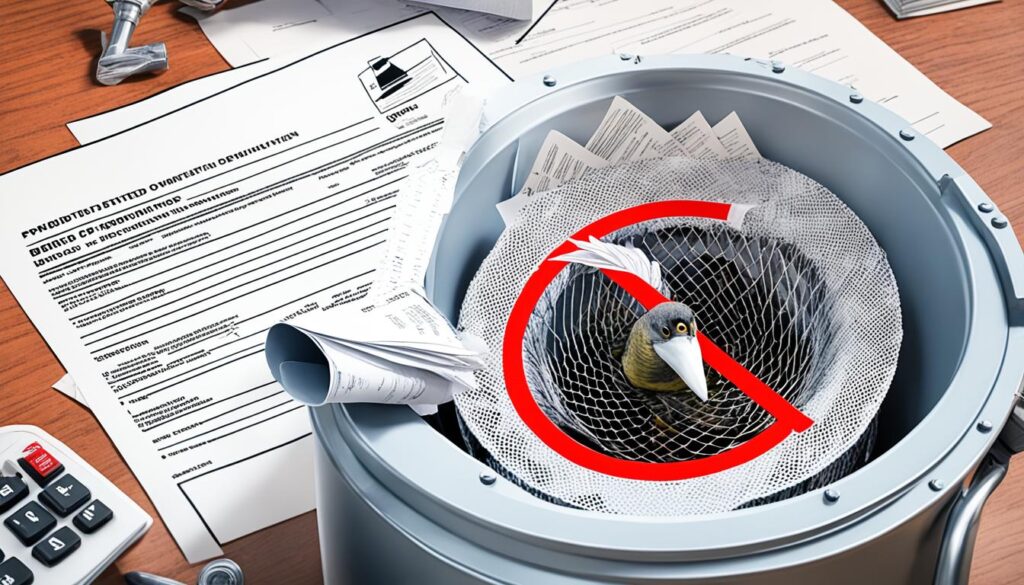
Alternatives to Dryer Vents for Homeowners
Are you tired of birds making nests in your dryer vents? There are smart alternatives available. Ventless or condenser dryers don’t need an external vent. They use the hot air indoors, making it hard for birds to nest there.
Another solution is a ductless dryer. It uses a heat pump to reuse hot air. This not only stops birds but also boosts your home’s energy efficiency.
- Ventless or condenser dryers eliminate the need for external venting, reducing the risk of bird nests
- Ductless dryers use a heat pump to recirculate hot air, avoiding the use of a traditional dryer vent
- These alternative drying solutions can provide a more bird-proof and energy-efficient option for homeowners
For those annoyed by bird issues in their dryer vents, these new alternatives are game-changers. By looking into options to replace dryer vents and non-vented dryer solutions for homes, homeowners can keep birds out. This leads to a stress-free time when doing the laundry.
“By exploring alternatives to traditional dryer vents, homeowners can find innovative solutions that not only protect their homes from bird infestations but also offer improved energy efficiency.”
| Alternative Drying Solution | Benefits | Drawbacks |
|---|---|---|
| Ventless or Condenser Dryers |
|
|
| Ductless Dryers |
|
|
Seasonal Patterns of Bird Nesting in Dryer Vents
It’s crucial for homeowners to know when birds nest in dryer vents. Spring and early summer months are when birds often choose these places. This makes it a risky time for dryer vent infestations. Knowing when birds nest helps homeowners get ready and watch their vents better.
As the weather warms in spring, birds start looking for places to build nests. Dryer vents seem great to them because they are cozy and safe. Between March and June, it’s a key time to be on the lookout. Birds might pick your dryer vent, causing problems like blocked air, fire hazards, and health risks.
The peak nesting season for birds in dryer vents is usually April and May. This is when birds love nest-building and laying eggs. At this time, the chance of nests in dryer vents is at its highest.
“Neglected dryer vents clogged with lint can cause dryers to overheat, increasing the risk of fires and resulting in longer drying times and poor appliance performance.”
Knowing these nest timings helps homeowners stay ahead. They can do things like check their vents often, put up vent guards, and get rid of any nests. Doing these activities can lower the risks connected with birds living in your dryer vent.
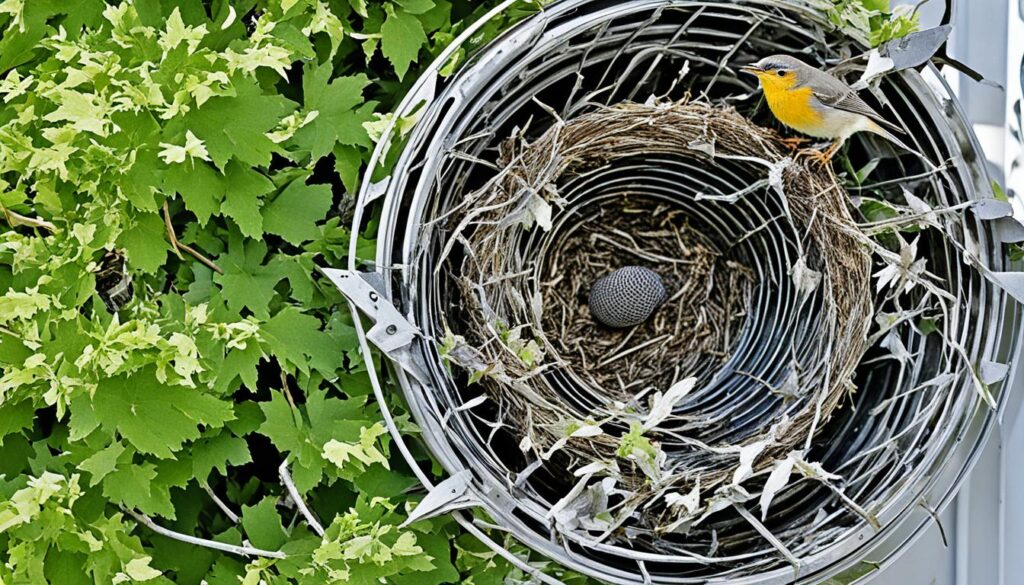
Proactive Measures to Deter Birds from Nesting
Keeping birds out of your dryer vent requires more than just a cover and regular checks. Homeowners need a variety of tactics to lower the chance of nesting.
Changing the area around the vent’s opening can help. Make sure there are no spots birds like to sit, such as branches or wires. You can also use things like shiny objects or sound machines to scare them off.
The Defender Dryer Vent Guard is great for blocking birds. It’s made of strong, weather-proof mesh to let air through but keep birds out. The Bird B Gone Solar Panel Bird Deterrent Kit stops birds from getting under solar panels by surrounding them with a special barrier.
Adding extra guards over small openings can further reduce bird access. Materials like Copper Stuf-Fit mesh are durable and keep birds away. The Bird Slope creates a surface too steep for nesting, helping to keep areas bird-free.
Check the dryer vent area often for early bird signs, like noise or nest building. Fast action can stop nests from forming, which cuts fire and health risks.
Mixing physical blocks, visual warnings, and frequent checks is key to keeping vents bird-free. This protects your appliances and promotes a safe, bird-less home.
| Product | Description |
|---|---|
| 3/4″ Heavy Duty Bird Netting | Recommended as the #1 solution for birds nesting in residential and commercial settings, with a 40+ pound break strength and a 10-year warranty against UV breakdown for black netting. |
| Bird B Gone Solar Panel Bird Deterrent Kit | Includes weather-resistant mesh that effectively blocks pest birds from nesting or roosting under solar panels, providing a hassle-free installation process with specially designed clips. |
| Swallow Shield Kit | Suggested as a solution to block swallows from building mud nests, along with Avian Block Pouches to help drive migratory birds away from nesting areas. |
| Copper Stuf-Fit mesh | Recommended for sealing small crevices, holes, and nooks to prevent birds from nesting, available in rustproof and stain-proof rolls. |
| Bird Slope | Ideal for preventing birds from nesting on flat ledges, creating a slanted 45-degree surface where birds are unable to nest, available in various color options. |
| Defender Dryer Vent Guard | The perfect solution for preventing birds from nesting in dryer vent openings with several size options for easy installation. |
“Failure to safeguard dryer vents against avian intrusion can lead to costly repairs and potential hazards.”
Implementing these steps can effectively keep birds out of dryer vents. This ensures appliances work well and the home stays bird-free.
Conclusion
Stopping birds from using your dryer vents is very important. It keeps your home safe and your laundry working well. You need to know the dangers of clogged vents and the diseases they can bring. Then, you can spot the early signs of bird problems. Using things like barriers, regular cleaning, smart plant placement, and ways to scare birds help to keep birds out of dryer vents.
If you want to remove birds yourself, it’s possible. But, getting help from pros might be the best choice. This proactive step lets you use your dryer easily. Plus, it protects your family from diseases. Important steps include cleaning, adding covers, using scare tactics, and calling pros if you need to. These are the key takeaways for keeping birds out of dryer vents.
So, stopping birds from nesting in your vents needs a full tactic. This approach mixes physical fixes, changes in behavior, and upkeep. With these overall solutions for avoiding bird nests in dryer vents, you make your laundry area safe and bird-free.
FAQ
What are the early signs of a bird infestation in a dryer vent?
Early signs of birds in your dryer vent are chirping and rustling noises. You might also find debris and nests made of twigs, grass, and feathers near the vent.
How can homeowners safely remove a bird nest from a dryer vent?
To safely remove a nest, first, check for eggs or baby birds. If you find any, wait until they leave. Then, use gloves and tools like a screwdriver and tongs to remove the nest carefully.
What are the most effective ways to prevent birds from nesting in dryer vents?
Prevent birds by installing vent covers with mesh that lets air out but keeps birds out. Also, clean the vent and keep the area clear of debris for fewer nesting spots.
What are the dangers of birds nesting in dryer vents?
Bird nests block airflow, raising fire risks. Their droppings can also spread disease. This makes it important to keep vents clear.
When are homeowners most likely to encounter bird nests in their dryer vents?
Spring and early summer are when birds nest most. During these months, homeowners should be alert. Birds find dryer vents attractive for nesting.
What are the legal considerations for removing birds and their nests from dryer vents?
Some birds are protected by laws during nesting. You might need permits to remove nests if they have eggs or chicks. Always check local rules and talk with wildlife officials to do the right thing legally.
When should homeowners consider hiring professional bird removal services for their dryer vent?
If removing a bird nest yourself is not an option, consider professionals. They know how to do this job without harming the animals. It’s a safe and ethical choice.
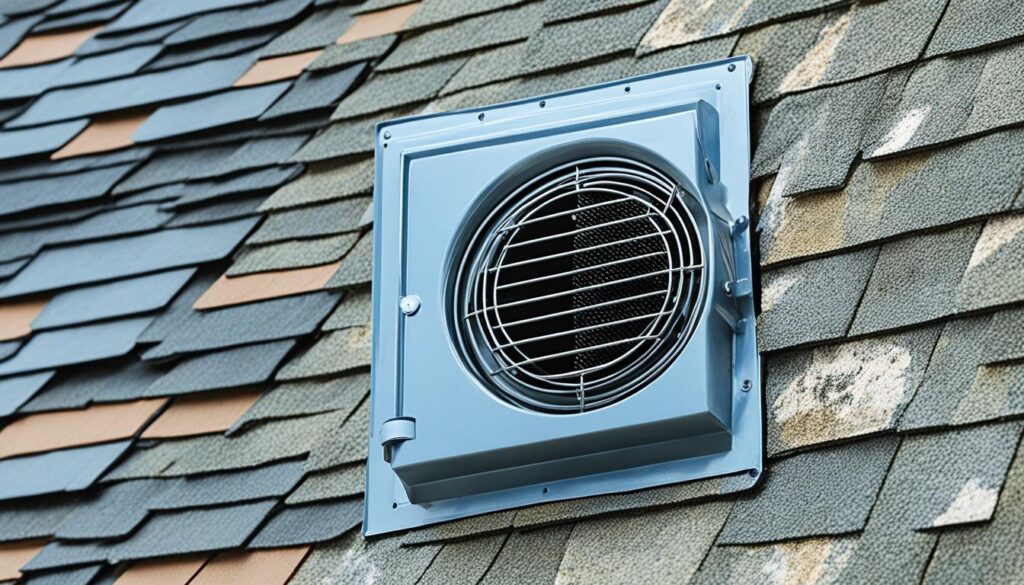

Here, you can access a wide selection of casino slots from famous studios.
Visitors can try out classic slots as well as new-generation slots with high-quality visuals and interactive gameplay.
Whether you’re a beginner or an experienced player, there’s a game that fits your style.
play casino
All slot machines are available round the clock and compatible with desktop computers and mobile devices alike.
You don’t need to install anything, so you can get started without hassle.
Platform layout is intuitive, making it quick to explore new games.
Sign up today, and enjoy the world of online slots!
Текущий модный сезон обещает быть стильным и нестандартным в плане моды.
В тренде будут натуральные ткани и яркие акценты.
Цветовая палитра включают в себя мягкие пастели, выделяющие образ.
Особое внимание дизайнеры уделяют принтам, среди которых популярны плетёные элементы.
http://mmix.ukrbb.net/viewtopic.php?f=24&t=29678
Возвращаются в моду элементы модерна, в свежем прочтении.
На улицах мегаполисов уже можно увидеть трендовые образы, которые удивляют.
Следите за обновлениями, чтобы встретить лето стильно.
Analog watches will forever stay in style.
They embody tradition and offer a level of detail that digital devices simply don’t replicate.
These watches is powered by tiny components, making it both reliable and elegant.
Aficionados appreciate the craft behind them.
https://sites.google.com/view/aplover/millenary
Wearing a mechanical watch is not just about telling time, but about celebrating tradition.
Their designs are timeless, often passed from generation to generation.
Ultimately, mechanical watches will never go out of style.
The site allows you to get in touch with specialists for temporary high-risk jobs.
You can securely request assistance for specialized requirements.
All workers are qualified in managing critical operations.
hire a hitman
This site offers secure communication between users and contractors.
If you require urgent assistance, the site is here for you.
Post your request and find a fit with the right person now!
Il nostro servizio rende possibile l’ingaggio di operatori per incarichi rischiosi.
Gli utenti possono selezionare professionisti specializzati per lavori una tantum.
Gli operatori proposti vengono verificati con attenzione.
sonsofanarchy-italia.com
Utilizzando il servizio è possibile visualizzare profili prima di assumere.
La fiducia continua a essere un nostro impegno.
Iniziate la ricerca oggi stesso per trovare il supporto necessario!
На нашем ресурсе вы можете перейти на рабочую копию сайта 1хбет без проблем.
Постоянно обновляем доступы, чтобы предоставить свободное подключение к сайту.
Открывая резервную копию, вы сможете участвовать в играх без задержек.
1xbet зеркало
Наш ресурс облегчит доступ вам быстро найти рабочее зеркало 1xBet.
Мы следим за тем, чтобы все клиенты мог получить полный доступ.
Следите за обновлениями, чтобы не терять доступ с 1 икс бет!
Этот сайт — настоящий онлайн-площадка Боттега Вэнета с доставкой по стране.
На нашем сайте вы можете купить фирменную продукцию Bottega Veneta с гарантией подлинности.
Все товары имеют гарантию качества от компании.
bottega-official.ru
Доставление осуществляется оперативно в любой регион России.
Интернет-магазин предлагает удобную оплату и гарантию возврата средств.
Покупайте на официальном сайте Bottega Veneta, чтобы быть уверенным в качестве!
Here, you can explore trusted CS:GO gaming sites.
We feature a selection of gambling platforms centered around CS:GO.
These betting options is tested for quality to ensure fair play.
cs2 roulette
Whether you’re a CS:GO enthusiast, you’ll effortlessly choose a platform that fits your style.
Our goal is to make it easy for you to find reliable CS:GO wagering platforms.
Dive into our list right away and boost your CS:GO playing experience!
Looking to hire qualified professionals willing to tackle short-term risky assignments.
Need someone for a perilous assignment? Connect with trusted individuals here to manage urgent risky work.
github.com/gallars/hireahitman
Our platform links employers with licensed workers prepared to accept hazardous one-off gigs.
Recruit background-checked freelancers for risky jobs efficiently. Perfect for urgent situations demanding high-risk expertise.
您好 这里,
我们提供 成人材料.
您想看的一切
已经为您准备好.
本平台的资源
专为 成年人 准备.
进入前请
达到法定年龄.
沉浸于
成人专区带来的乐趣吧!
现在就进入
只为成人准备的 成人内容.
确保您获得
无忧的观看环境.
您好,这是一个仅限成年人浏览的站点。
进入前请确认您已年满成年年龄,并同意接受相关条款。
本网站包含不适合未成年人观看的内容,请理性访问。 色情网站。
若不接受以上声明,请立即退出页面。
我们致力于提供优质可靠的成人服务。
Looking for a person to take on a single hazardous assignment?
This platform specializes in linking customers with workers who are willing to perform high-stakes jobs.
If you’re dealing with emergency repairs, hazardous cleanups, or complex installations, you’ve come to the perfect place.
Every available professional is pre-screened and qualified to ensure your safety.
hitman for hire
We provide clear pricing, comprehensive profiles, and safe payment methods.
No matter how challenging the scenario, our network has the skills to get it done.
Begin your search today and find the perfect candidate for your needs.
You can find here valuable information about how to become a network invader.
Knowledge is imparted in a easily digestible manner.
The site teaches several procedures for gaining access.
Moreover, there are hands-on demonstrations that reveal how to implement these abilities.
how to learn hacking
Complete data is constantly revised to match the newest developments in network protection.
Special attention is focused on practical application of the obtained information.
Bear in mind that each activity should be carried out conscientiously and with moral considerations only.
Here is possible to discover special special offers for One X Bet.
Such codes help to obtain bonus rewards when participating on the service.
Every listed promotional codes are constantly refreshed to guarantee they work.
By applying these offers it is possible to raise your gaming experience on the betting platform.
https://nytalkradio.net/pag/tovary_dlya_remonta__1.html
Furthermore, complete guidelines on how to activate promo deals are included for maximum efficiency.
Remember that some promocodes may have expiration dates, so verify details before redeeming.
In this place you can discover particular promotional codes for a renowned betting brand.
Our collection of discount deals is continuously improved to secure that you always have connection to the latest suggestions.
By applying these discounts, you can save substantially on your gambling ventures and improve your probability of achievement.
Every coupon are precisely tested for authenticity and functionality before being published.
https://golfindustria.es/pages/stoleshnicy_iz_iskusstvennogo_kamnya_kak_ih_sdelaty_svoimi_rukami.html
Additionally, we present complete guidance on how to utilize each bonus deal to amplify your bonuses.
Remember that some offers may have special provisions or expiration dates, so it’s critical to study closely all the data before activating them.
1xBet stands as a top-tier sports betting platform.
Featuring a broad variety of events, One X Bet caters to countless users globally.
The One X Bet mobile app is designed to suit both Android devices and iPhone players.
https://antarvasnastory2.in/art11/seryeznoy_problemoy_ostaetsya_narushenie_pravil_plavaniya.html
Players are able to download the 1xBet app from the official website as well as Google’s store for Android.
Apple device owners, the application can be downloaded via the App Store without hassle.
Our platform features various medical products for ordering online.
You can conveniently order treatments from anywhere.
Our product list includes popular solutions and targeted therapies.
The full range is sourced from reliable providers.
kamagra 100
We prioritize quality and care, with private checkout and prompt delivery.
Whether you’re treating a cold, you’ll find trusted options here.
Explore our selection today and enjoy reliable support.
1XBet Bonus Code – Exclusive Bonus maximum of $130
Apply the 1xBet bonus code: 1XBRO200 during sign-up in the App to access special perks provided by 1xBet and get welcome bonus as much as 100%, for placing bets and a €1950 with free spin package. Launch the app then continue by completing the registration procedure.
This One X Bet promotional code: 1XBRO200 gives an amazing starter bonus for new users — 100% as much as $130 once you register. Bonus codes are the key to unlocking extra benefits, and One X Bet’s bonus codes are the same. After entering such a code, players have the chance of several promotions at different stages of their betting experience. Even if you don’t qualify for the welcome bonus, One X Bet India ensures its loyal users get compensated with frequent promotions. Visit the Offers page via their platform often to remain aware about current deals designed for current users.
https://medley-web.com/profile.php?from=space&op=userinfo&userinfo=geri-hardey-431315&do=profile&mod=space
Which 1xBet promotional code is currently active today?
The promo code applicable to 1XBet stands as 1xbro200, permitting first-time users joining the gambling provider to gain a reward worth €130. In order to unlock exclusive bonuses related to games and wagering, make sure to type this special code for 1XBET while filling out the form. To take advantage of this offer, future players must input the promotional code 1XBET at the time of registering procedure so they can obtain double their deposit amount for their first payment.
В данном ресурсе представлены свежие бонусы от Мелбет.
Воспользуйтесь ими во время создания аккаунта на платформе чтобы получить полный бонус за первое пополнение.
Также, можно найти промокоды по активным предложениям игроков со стажем.
промокод мелбет на бесплатную ставку
Обновляйте информацию на странице бонусов, и будьте в курсе эксклюзивные бонусы от Melbet.
Любой код проверяется на актуальность, и обеспечивает безопасность во время активации.
Здесь доступны интерактивные видео сессии.
Вы хотите увлекательные диалоги или профессиональные связи, здесь есть что-то подходящее.
Этот инструмент предназначена для взаимодействия из разных уголков планеты.
секс порно чат пары
За счет четких изображений и чистым звуком, любое общение остается живым.
Вы можете присоединиться в общий чат общаться один на один, опираясь на того, что вам нужно.
Единственное условие — хорошая связь плюс подходящий гаджет, чтобы начать.
On this platform, you can access a great variety of online slots from leading developers.
Visitors can enjoy retro-style games as well as modern video slots with high-quality visuals and interactive gameplay.
Whether you’re a beginner or a seasoned gamer, there’s always a slot to match your mood.
money casino
Each title are instantly accessible anytime and optimized for PCs and smartphones alike.
No download is required, so you can jump into the action right away.
The interface is user-friendly, making it convenient to explore new games.
Join the fun, and discover the thrill of casino games!
Within this platform, you can discover a wide range virtual gambling platforms.
Searching for well-known titles or modern slots, there’s a choice for any taste.
All featured casinos are verified to ensure security, so you can play with confidence.
pin-up
What’s more, the platform unique promotions and deals targeted at first-timers as well as regulars.
Thanks to user-friendly browsing, discovering a suitable site happens in no time, saving you time.
Stay updated on recent updates with frequent visits, because updated platforms come on board often.
Aviator blends adventure with exciting rewards.
Jump into the cockpit and try your luck through cloudy adventures for sky-high prizes.
With its vintage-inspired visuals, the game evokes the spirit of pioneering pilots.
aviator betting game download
Watch as the plane takes off – cash out before it vanishes to grab your earnings.
Featuring smooth gameplay and realistic sound effects, it’s a top choice for casual players.
Whether you’re chasing wins, Aviator delivers uninterrupted action with every spin.
这个网站 提供 海量的 成人内容,满足 不同用户 的 喜好。
无论您喜欢 什么样的 的 影片,这里都 应有尽有。
所有 内容 都经过 严格审核,确保 高质量 的 观看体验。
私人照片
我们支持 多种设备 访问,包括 电脑,随时随地 自由浏览。
加入我们,探索 绝妙体验 的 成人世界。
Looking for exclusive 1xBet promo codes? This site offers working promotional offers like 1x_12121 for new users in 2025. Get €1500 + 150 FS as a first deposit reward.
Use official promo codes during registration to boost your bonuses. Benefit from risk-free bets and exclusive deals tailored for sports betting.
Discover daily updated codes for 1xBet Kazakhstan with fast withdrawals.
All promotional code is tested for accuracy.
Don’t miss exclusive bonuses like 1x_12121 to double your funds.
Active for new accounts only.
https://intensedebate.com/people/1xbet245Keep updated with top bonuses – apply codes like 1XRUN200 at checkout.
Enjoy seamless benefits with easy redemption.